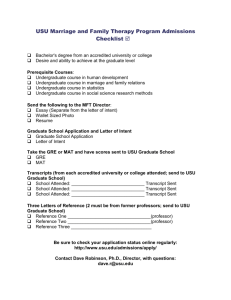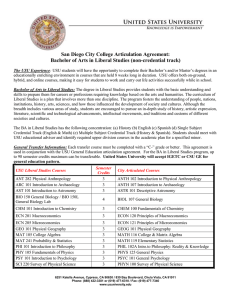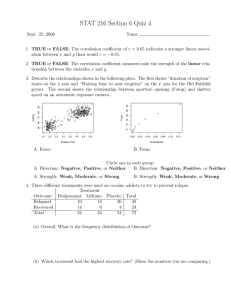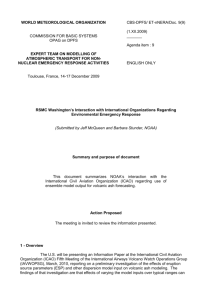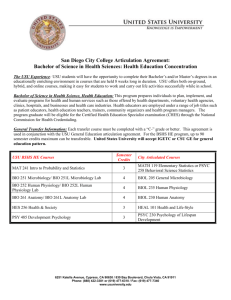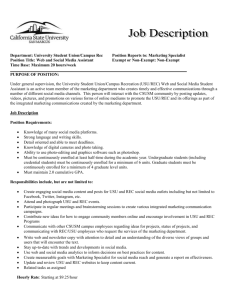Study on Plant Damage Caused ... Usu Eruption Using Remote Sensing Shigeru TAKAHATA
advertisement
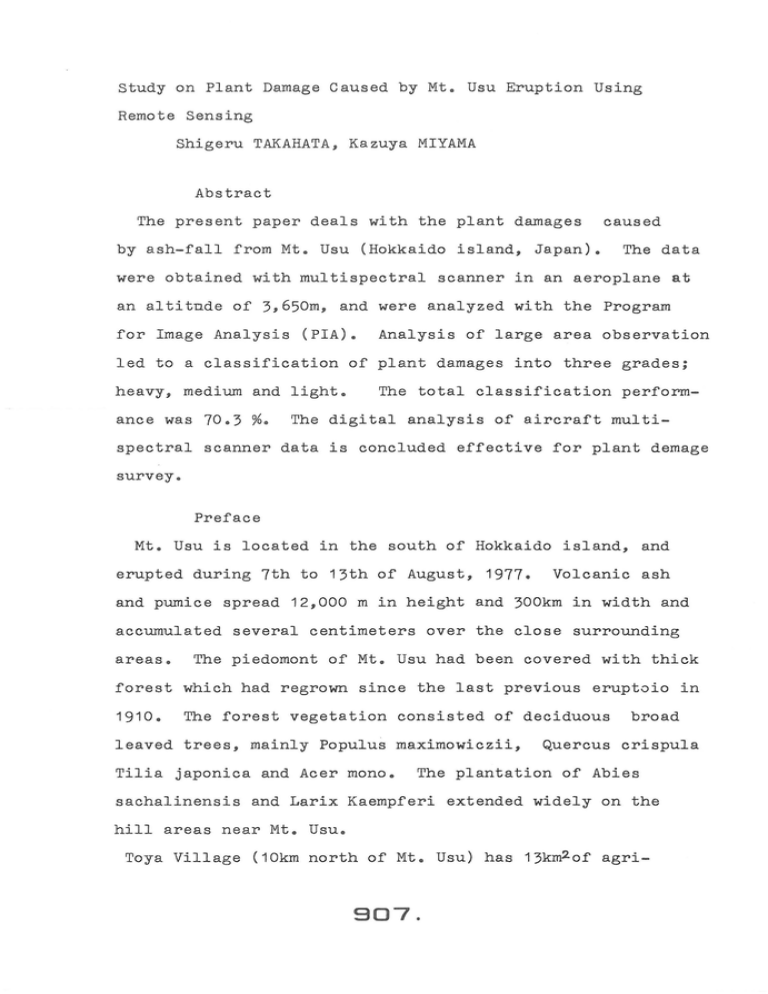
Study on Plant Damage Caused by Mt . Usu Eruption Using Remote Sensing Shigeru TAKAHATA , Kazuya MIYAMA Abstract The present paper deals with the plant damages caused by ash- fall from Mt . Usu (Hokkaido island , Japan) . The data were obtained with multispectral scanner in an aeroplane at an altitude of 3,650m , and were analyzed with the Program for Image Analysis (PIA) . Analysis of large area observation led to a classification of plant damages into three grades; heavy , medium and light . ance was 70 . 3 %. The total classification perform- The digital analysis o.f aircraft multi - spectral scanner data is concluded effective for plant demage survey . Preface Mt . Usu is located in the south of Hokkaido island, and erupted during 7th to 13th of August, 1977 . Volcanic ash and pumice spread 12,000 m in height and 300km in width and accumulated several centimeters over the close surrounding areas . The piedomont of Mt . Usu had been covered with thick forest which had regrown since the last previous eruptoio in 1910 . The forest vegetation consisted of deciduous leaved trees , mainly Populus maximowiczii, Tilia japonica and Acer mono . broad Quercus crispula The plantation of Abies sachalinensis and Larix Kaempferi extended widely on the hill areas near Mt . Usu . Toya Village (10km north of Mt . Usu) has 13km2of agri - 907. cultural fields , and produces mainly potato , corn , red been , vegetables and paddy rice . Mt . Usu has shown periodic activities • In recent years , it erupted in the years 1663 , 1769 , 1822 , 1853 and 1910 . The first eruption the 1977 activity occurred at 9 : 30 , August 1. The wind was blowing north at 10 m/s . Thus the volcanic ash and pumice from this eruption fell thick over the southern foot of Mt . Usu . at 15:00 the next day . The second big eruption occurred Since strong south wind was blowing at that time , ash was carried far toward the northern foot of Mt . Usu . Rain started soon after the carried down fine ash with rain drop . eruption and The ash adhered onto leaves of plantation like mortar . Fig 1 illustrates damages of plants caused by volcanic action of Mt . Usu . Eruption pischargej ticking (wet ash) Volcanic Act ion Diastrophism Fig 1 Ground slide~------------~ Relation of Volcanic Action and Plant Damage 908. cut Method The process of analysis is illustrated in Fig 2 . Classification was carried out by the most likelihood method . Large scale Ground air photos trouth Unsupervised classification Statistics of each traini ng field Interoperation between channels of f i eld Estimation of divergency of Supervised classification Map of operational results Fig 2 Study Flo w Date Acquisition We acquired the follo wing data which we used for the analys i s of plant demage . 909. Date Agency 8 . 21 , 1972 NASA Before 7 . 01 , 1973 NASA Er'uption 5 . 30 , 1977 Geographical Survey Inst . 6 . 04 , 1977 Code Name of Ope r at i on ···- Scale LANDSAT 1 Type HSS LANDSAT 1 MSS 1: C0lor 10 , 000 photo CH0- 76 - 12 CH0 - 76 - 8 LANDSAT 2 8 . 12 , 1977 NASA After Eruption 8 . 14 , 1977 KOKUSAI AeriaJ. K- 773 Survey Ltd . 8 . 30 , 1977 JAFSA 9 . 17 , 1977 NASA 9 . 22 , 1977 ASIA Aerial Survey Ltd . MSS 1: MBC 20 , 000 MSS LANDSAT 2 MSS 1: 8 , 000 Co l or photo Table 1 Data Large scale color photographs were used to interprete the ground conditions . In the midst of eruption at August 12 , LANDSAT 2 had just passed over the Usu area . We could recognize the smoke from Mt . Usu on the LANDSAT 2 data , but we could not observe the ground conditions on account of thick cloud . Just after the eruption , multi - band photographs were taken over the Usu area and we could observe the damaged surface by me ans of an additive color viewer . Japan Foundation for Shipbuilding Advancement (JAFSA) takes an air- borne HSS data which were recorded on 21st and 30th of August . Results 1. Interpretation of Aerial Photographs The ground trouth can be uncovered by correct interpretation of the large scale aerial photographs . We were able to identify the kind of crops in the color photographs , eventhough they are buried under the ash (Table 2) . 910. Table 2 General Key to Identification of Ash- covered Fields (Color Photography , Scale 1 : 10 , 000) Key to identification by means of color and texture of photography and field size Symbol Crops A Red been Dark gray , smooth texture , small size B Sugar beet Light gray, smooth texture , large size c Co rn Light dark gray , distinct and v e r t ical crop l i ne p Potato Light gray, clear couble trace of t r acto r wheels As Asparagus Light dark green , distinct outline of field , located along river K Kidney been Greenish gray , rough tex t ure , medium size y Vegetables Light gray , gradual density pattern caused by d i fferent harvesting time , small size G Pasture Light gray spotted with dark patches , flat texture z Bare soil Yellowish brown 2. Classifi cation of Damaged Fi elds by MSS Digital Analysis An area of 1km t est area . X 1km in Kagawa district was se ; ected as a This is a typical , flat farmland . from channels Using data 5, 7, 8 , 9, 10 and 11 the ground conditions were classified into five categories by the unsupervised likelihood method . According to this classification , damaged fields correspond to three of them : most the 1) Those which partially r e tains green --- paddy ric e , asparagus ( damage especially light) , sugar beet (quick regrowth) and kidney been (supported by p r ops) ; 2) Those which shows no sign of green --- potato (completely buried) ; 3) Those which looks impure g reen --- corn , red been (harf buried) . 911. Other t wo are " Lake " and " Residental area or Bare so i l ". The supervised , mo st likelihood classifi cation method was appl ied using t welve categori es . The opt i mum combination of channels were de c ided as that of 7 , 9 and 1 1 based on the i n terclass d i ve r gence . Av erage pe r formance of the classificat i on was 7 5 . 5 %. Table 3 Performance of Class i ficat i on , Kagawa district Numbe r Category of pixels 109 12 1 . Beet 2 . Rice 3 . Asparagus Trai ning f i e l d Performance % 1 2 4 3 5 ( 89 .0) (91. 7) 4 . Kidney been 73 1.4 5 . Corn 63 c 6 . Red been 65 10 . Forest (flat ) 11. Forest \, slope) 1 2 . Wate r 3. 9 8.3 .~. \.) 12 ~ ' 8.2 (83.8) ~"J . :) ~ 8.1 ' ,·, 2. 7 ' ~-- 2. 7 (87. 7) ,--, ' '• . } 1.6 .: 1.5 ,. • ) r, ,, r, . 7.9 - ,.. 0 .7 ("' n 0.7 6.3 <...: 4.6 1.5 3 .3 0 .4 f_,l ~ '- .. 3.0 ( 84.3) . 2.2 -~. ' r '·· ., (64.6) '• - -·- --r-9.5 0.7 (83. 6) 1. 8 ....., ·' 5.6 23.8 27.7 ,,,. n ·-. ( 60.3) ·-· 45 18 270 . 11 .-, ·.. 0 .9 ) 1 34 9 . Residences 4.6 " 37 275 4. 6 10 9 .. 5.4 ? . Potato 8 . Bare soil 0.9 8 7 6 7.5 1.5 3. 7 6.7 8.9 " . -- " 5.6 16. 7 1 '5 3.7 1.5 - -- · 28.9 (53 .3) ---- - ---·- - 5.6 5.6 11.1 (55.6) 5.9 8.9 8.! 11.9 (51 .9) " '·' .. , ' ' '- 0.4 ooo: Classification of Toya Dist r ict by MSS Dig ital Analysis An area of 5 . 5km X 9km , located about 10km n orth of Mt . Usu was chosen as the test area . ash - fall . Thi s a r ea suffe r ed 1 to 10 cm of The unsupervised classification failed to identify diffe r ent d eg rees of ash-f al l. This is because the classific a t i on of field and forest c r ossed each other . 9:1.2. The supervised classification method worked by using 7 , 8 and 10 channels . Table 4 shows successful classification of different degrees in damage caused by ash-fall . •rable 4 Performance of classification , Toya District Depth of Dmage ash- fall grade Category 1 • Field A f------ 2 . It,ield B 3. Field c 5cm 2 1 4 . Forest A 10 - 5 5 . Forest E 3 6 . Forest c 1 7 . Forest F 2 8 . Town 5 -·--- - f--· 9 . Lake Heavy Medium Number Performance % of 2 3 4 5 6 pixels 1 84 105 Light 60 Heavy 84 Medium Light Medium (61. 9) 11.9 19.0 3.6 +- · - -- f - - - f-- - 1.0 2.9 75 96 78 40 60 13 .3 (58.1 14.3 , -.. ' ' 6.7 2.1 ,. 2.5 ~64.3) .. ·- --. 2.1 - 6.4 ·' 9 3.6 (~ . - ,. 1.7 4.2 8 1.9 8.6 a>.o 78.3 13.1 7 2.4 88.0 '. 1.3 ~· .. 20.2 2.7 2.7 91. 7) .~_) - 92.3 " 20.0 ,, . ' '. 77.5 ', ' .. (IOO J, The spectral value of ch . 7 and 10 was converse in· connection with the depth of ash-fall . relation . Fig 3 shows this The difference in spectral values of channels 10 and 7 has a highly negative correlation with the depth of as - fall . 6 R = - 97 . 5 log t + 53 . 8 ( 1 < t < 12. 5cm) 6R r = - 0 . 976 Difference in CCT counts of ch . 10 and 7 . t Depth of ash- fall (em) r Correlation coefficient 9:1.3. rl CIS ,.q• :> (.) rl ..-- CIS H .p correlation with spectral value Fig 3 <D ;:3 t- (ch . 10 - ch . 7 ) and ash- fall depth I 0 80 ,.q• (.) (.) <D ....__. 40 I I • fie ld o forest J I ' t,,,', t' '~ , '1 P.t !T.I \\ ' ' O"E= "~ 9J 4 ' '~ ' ""' ' -•o 0 ' ~' 0 ' -BO 10 0 • :!0 30 so t : depth of ash- fall (em ) Conclusions We often suffer from the natural disaster such as volcanic activities , floods , typhoons and droughts . It is most important to recognize the extent of disaster immediately and extensively as soon as it happens . For this purpose , the remote sensing technique is effective . In the caurse of this study , we prepared a map of plant damages baced on the MSS data , and the map was utilized in the planning of restration and also in the compensation problems . The r e liability of damage map depends on the timing of observation . If we can obtain the data immediately after the incident , the result of analysis is most accurate . We emphasize the necessity of establishing a dynamic system which can handle the emergency without loss of time . References i)Hokkaido Agric . Exp . Sta . (1978) ; Report of Surveying on the Agricultural Disasters Caused by the 1977 Eruption of Usu Volcano, Hokkaido , Japan . 2) Maesaki , T., Suzuki , H. (1979) ; Classification of Forest Tree Damage Caused by the Eruption of Usu Volcano Using MSS Data , Bulletin of Hokkaido Forest Exp . Sta . , No 17 . 3) Takahata , s ., others (1978) ; Studies on the Agricultural Damage Caused by Mt . Usu Eruption Using Remote Sensing , Res . Bulletin of Hokkaido Agric . Exp . Sta . No123 . 4) Miyama , K. , Takahata, S . and Fukuhara , M. (1979) ; A D~gital Analysis of Agrecultural Damage Caused by Mt . Usu Eruption Using Aircraft MSS Data, Photogrammetry, Journal of the Japan Soc . of Vol 18, No 1 . 915.

